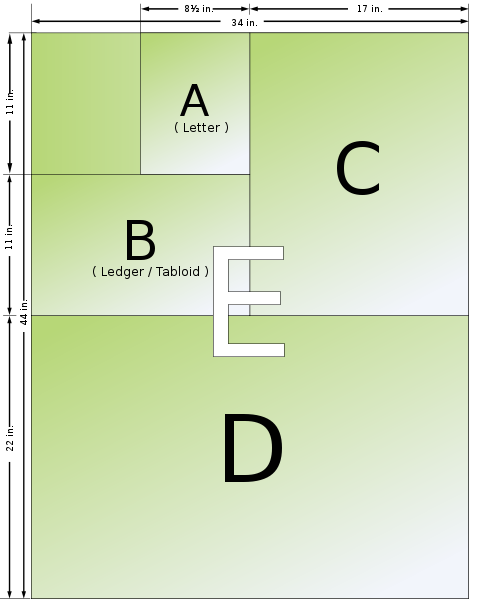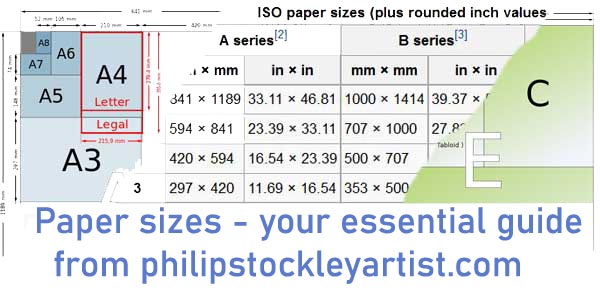
OK, this may not be the most exciting topic in the world, but it could save you a ton of hassle and money in many creative situations.
Why? Well, think about this.
Your decision on the size of paper to use will have an impact on cost and usability in all the situations listed below:
- the size of artwork or greetings cards you want to make
- If you want to photocopy – especially when you want to ‘scale’ (enlarge or decrease) the resulting photocopy size
- When you want to post your work and need to work out the weight to benefit from the cheapest possible postage costs.
- If you want to frame your work
- When you want to share your work – digitally (as a document or PDF); or in printed format using a home printer, office printer or a commercial printer
- If you want to share your work internationally – especially between North America and the rest of the world.
- If you want to write for an audience and want to share printed copies of your writing.
- If you want to file work in binders, or store your work in cabinets or bookcases
- Using software – such as graphics packages, where there will be some form of output
- If you design software which will have an option to print.
- If you are creating ‘official’ documents such as credit card size membership cards.
A quick history of paper sizes
If we think about it at all, we tend to think that the paper sizes we use everyday are common across the world. Historically this was not true, as until recently different countries set their own standards for paper sizes. Fortunately, the confusing range of paper sizes prevalent in the early 1900’s has given way to two main systems used internationally today.
Grossly simplifying, they are:
1) The metric ISO system, including ISO 216.
(“ISO” stands for the “International Organization for Standardization” and their ‘standard 216’ is based on the German Institute for Standardization’s “DIN 476” standard adopted by Germany in the 1920s). Now most countries in the world have adopted ISO 216 and related standards. This metric based system defines the “A”, “B” and “C” series of paper sizes, plus some less well known sizes. Over time there have been variations based on this system (such as the Japanese JIS ‘A’ and ‘B’ series).
2) The North American ‘Imperial’ based system
This system, based on measurement in ‘inches’ is still used in the USA and Canada. A few countries use both the ISO standard and the US letter format – including Mexico, Chile, Costa Rica, Columbia, Venezuela and the Philippines.
In 1995 the ANSI (American National Standards Institute) adopted a new standard for paper sizes (named the ‘ASME Y14.1’ standard) which defined the American ‘Letter’ format as ANSI A and the ‘Ledger’ or ‘Tabloid’ format as ANSI B. This format could be described as the American answer to the ISO paper standards – more of which later.
The most commonly used paper sizes in the world are the ISO’s ‘A4’, and the US based ‘letter’ size (Also known as ANSI A).
The great advantages of the ISO standard.
The most common paper standard, ISO 216, is a metric based system where the largest A0 size has an area of 1 square meter. The weight in grams of this sheet is also important, as it helps you to know what that weight of paper can be used for, and to calculate how heavy ‘X’ number of sheets of a specific size of paper will be.
The ISO standard is based on the idea of using a ‘single aspect ratio’ for all paper sizes. In layman’s terms this is where the relationship between the width and height of a piece of paper has the same proportion no matter how big or small it is. The ‘A’ paper size uses the ratio “1: the square root of 2” (approximately 1 units wide by 1.4142 high) to define the paper sizes. (Don’t worry about the maths – Wikipedia go into great detail about this ratio for those who want to understand more).
In practical terms the ISO standard means you can ‘scale’ the paper size, and calculate the weight of one or more sheets of paper.
This works because the base sheet of paper (A0) has an area which is 1 Meter squared (841mm by 1,189 mm (33.1 in × 46.8 in)). When it is folded or cut in half, two sheets of half the area are produced – called A1 size. Do the same to the A1 sheet, and you get 2 x A2 sheets, and so on. Each smaller size is half the area of the larger sheet. So you know that, for example, an A4 size piece of paper becomes an A5 size card when folded. Being able to scale the ISO paper means it is possible to photocopy a document and increase or decrease its size without losing any of the document – something which is not so easy with the North American system.
It is also possible to work out the weight of a piece of paper – so, for example, 80 gram paper per square meter (the A0 page size) means an A4 sheet (you get 16 from an A0 sheet) weights 5 grams (80 grams divided by 16 = 5 grams). So, if you want to know the weight of 100 similar A4 sized pieces of paper, you multiply 5 grams by 100, to give 500 grams. If you know the weight of any bindings and envelopes you may use, you can then work out your postage costs.
The B series of paper sizes are often used for posters and in the printing industry (along with other different paper size standards), as this gives the printer the ability to trim the paper size down to the A series size if necessary. C series paper sizes are often used for envelopes, so for example, an A4 piece of paper will fit inside a C4 envelope.
If you are into technical drawing, ISO218 specifies pen nib widths to use with the different sizes of ISO126 paper (particularly the A series) – so if a technical drawing is shrunk or increased in size, a different pen nib width can be used to continue the drawing with the same line width.
The American inch-based system.
The American system uses paper sizes which are more confusing and generally less predictable. The main sizes are called: Letter, legal, ledger, and tabloid. The ANSI format is very roughly equivalent to ISO paper sizes. For example, the ‘letter’ size is 8.5” x 11” (215.9mm x 279.4mm) and is slightly shorter and wider than the ISO’s A4 size (8.27” x 11.69” (210mm x 297mm).
The North American system is based on two different ‘apect ratios’ – in other words, if you half the paper size you use one ratio, and to half it again needs a second ratio. This means it is much harder to scale the paper sizes, and it is also difficult to work out the weight of a single piece of paper, as the sizes of the different paper sizes are not determinded by one mathematical progression.
Conclusion
No paper size system is perfect for all uses, so there a range of variations have been adopted for various situations and industries. However, the ISO standard, and especially the ‘A’ series of paper sizes, is very useful for the majority of people.
Being aware how and why paper sizes have been standardised, and how the American and ISO systems differ, can help you ask the right questions, avoid problems, and save money and hassle by using standardised sizes as far as possible.
Images and measurements
The ISO ‘A’ paper sizes
The measurements of the ISO A, B and C paper sizes are shown below, thanks to wikipedia.
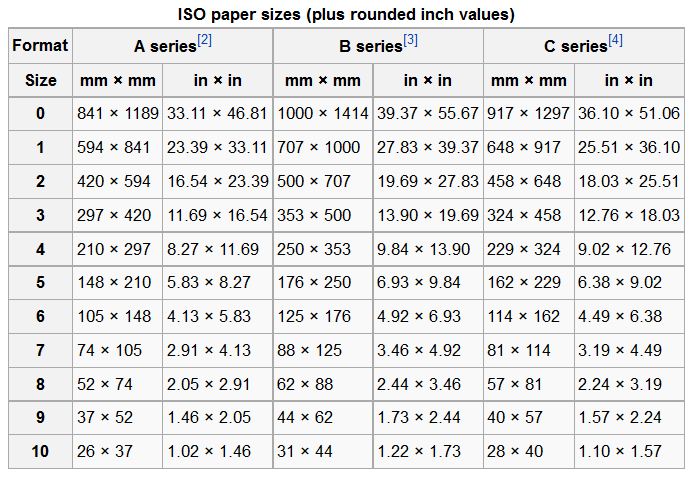
This image shows the ‘A’ paper series. The red lines show how the American Letter and Legal sizes relate to an A4 page.
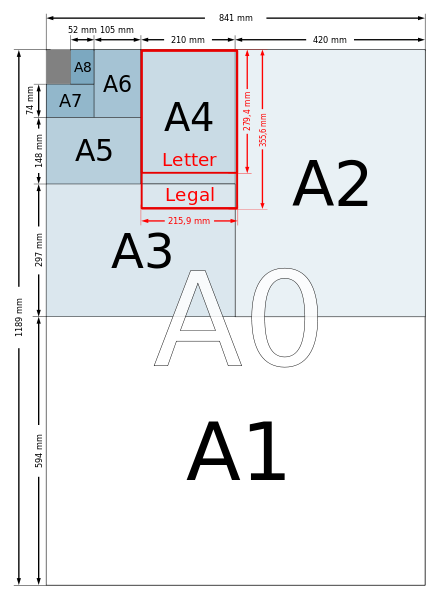
This image shows the ISO ‘B’ paper series.

This image shows the ISO ‘C’ paper series.

The American paper sizes and how they relate to the ISO A4 sizes
This table from wikipedia shows the main ANSI paper sizes and ISO equivalents
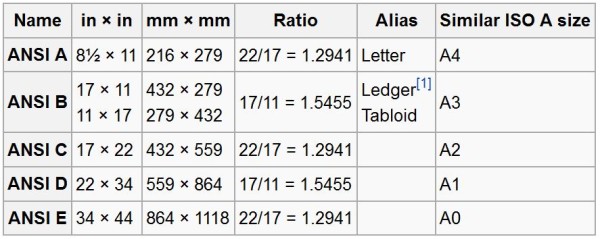
And finally
Check back here for a summary of watercolour paper sizes, and common standard frame sizes – coming soon.
